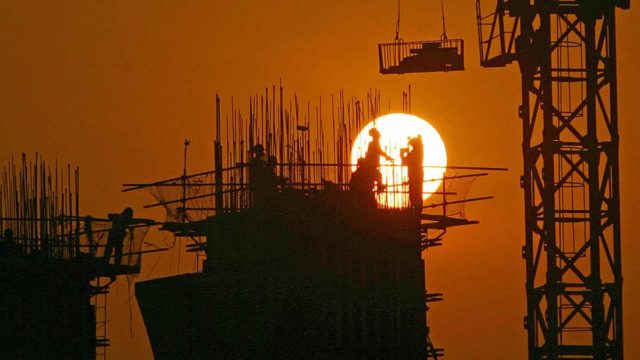China’s economy is definitely slowing and that will have a knock-on effect for miners, but there is some question as to just how much it has slowed.
The government has set itself a GDP growth target of 6 to 6.5 per cent for 2019, which is already lower than last year’s 6.6 per cent.
Typically known as a “powerhouse”, it would seem the country is anything but right now, with an apparent lack of people and traffic.
Niv Dagan, executive director at boutique investment firm Peak Asset Management, has just returned from a trip to Beijing and he certainly noticed it.
“Having landed in Beijing airport at 4pm on a Wednesday afternoon, a city supposedly of over 21 million people, I was amazed to see the lack of foot traffic, retail shops were closed and restaurants empty,” he told Stockhead.
“As we took off at 6:30pm looking down at the city, the streets were also empty, there were no traffic jams and evidence of little activity down below.
“It also appeared that the majority of skyscrapers were empty, and we quickly came to the realisation that Beijing is really just a ‘ghost-city’.
“Is the GDP figure for China 6.5 per cent or really 3.5 per cent?”

It has been widely reported that the Chinese economy has slowed quite a bit, but the outlook is that the decline will likely be stemmed by mid-year.
Shaun Roache, chief economist for the Asia Pacific region for S&P Global Ratings, said that while growth will slow this year for sure, China should still meet its 6 to 6.5 per cent target.
“If they sat back and did nothing, I think the economy would continue to slow because there are issues that are putting downward pressure on growth, like high debt levels,” he told Stockhead.
“But they’re not just sitting back and letting things happen. They are starting to change policies.”
Mr Roache said the reason growth had slowed in China in the first place was because of the country’s fiscal tightening.
“By the end of last year, I think they clearly recognised they had overdone it, but started to reverse that tightening a little bit,” he said.
China took steps like cutting interest rates, allowing banks greater freedom to lend to local governments and relaxing rules around bond issues by governments.
“This is slowly having an impact, and if you look at the latest credit numbers, they’ve picked up a lot, which is suggesting that in fact growth should stabilise by the middle of this year,” Mr Roache said
“So getting to between 6 and 6.5 per cent seems achievable for sure this year.”
So how will commodities fare?
Last year, China’s weaker investment in infrastructure saw a decline in demand for commodities, which meant prices took a bit of a hit.
The US-China trade war also didn’t help, creating more uncertainty in an already volatile market.
Although China was building less roads and railways, the real estate sector remained buoyant, which helped prop up demand for commodities.
Mr Roache said investment by real estate developers grew by about 8 to 9 per cent, which was “pretty good”.
“As we go into this year, real estate investment is going to slow because the housing market has turned, but it’s not going to slow that much,” he said.
“The housing market looks healthier now than it did a few years ago.”
On top of that, China is not expected to suffer the same pressures on infrastructure investment this year.
“When you put it altogether the outlook for commodity demand in China is not too bad,” Mr Roache said.
“It might weaken a bit, but not much and as long as growth stabilises as we expect I think the impact won’t be so bad.”
China’s demand for iron ore isn’t coming back
China, however, is starting to need less of Australia’s abundant iron ore and coal resources.
Joe Moloney, senior economist with the federal Department of Industry, Innovation and Science, said at an industry conference recently that China’s steel demand peaked back in 2017 and the forecast is that it will fall further over the next five years.
China’s crude steel demand is expected to dip by a further 40 million tonnes by 2024.
S&P Global Ratings’ Mr Roache said the decline was largely due to strict supply-side reforms that sent a lot of smaller private sector steel producers packing.
“That supply-side reform has slowed down a bit, but it may come back, and the reason it may come back is that already we’re starting to see as commodity prices just stop going up, the margins at steel producers fall very quickly,” he said.
- Subscribe to our daily newsletter
- Join our small cap Facebook group
- Follow us on Facebook or Twitter
This week China released its industrial profits data, which showed a 10 per cent year-on-year drop — the biggest decline since 2016.
“So the bottom line here is that the overcapacity sectors in China, including steel, are still not in great shape and it looks like demand for iron ore in a structural sense has peaked and will continue to slow,” Mr Roache said.
The good news though is that it won’t completely collapse in 2019, “so long as real estate and infrastructure growth is still okay”.
Will China boot coal in favour of LNG?
In February, China implemented a ban on the import of Australian coal from certain ports, and while some commentators believe the ban may only be short-term, there is now the suggestion it could be longer-term.
Mr Roache pointed to the potential US-China trade deal set to be made public in late April.
“It looks like China is going to commit to buying substantially more LNG from the US,” he said.
“And what are they going to do with all this stuff? They’re going to have to generate power from it.”
Basically, it all comes down to China’s plan for that extra LNG.
The coal sector may be okay if China just switches out Aussie LNG for the new US LNG.
But that will see Australia lose market share of LNG, and right now the country is the biggest supplier to China.
“If they don’t do that, if they just consume more LNG, they’re going to have to consume less of something else and that less of something else is probably going to be coal,” Mr Roache said.
“That’s not going to happen overnight because you have to change power stations from coal to LNG powered power stations, but that could be a big implication of the US-China trade deal.
“So that’s something to watch very carefully because it will have indirect implications for coal over the next two to three years.”








